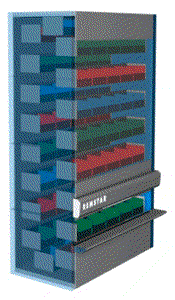| LITR 4368 Literature of the Future Homepage / Syllabus Course webpage: http://coursesite.uhcl.edu/HSH/Whitec/LITR/4632/default.html Instructor:Craig White Office: 2529-7 Bayou Phone: 281 283 3380 E-mail: whiteC@uhcl.edu Office Hours: M 4-6, T 4-7, and by appointment |
 Graduate Seminar: Literary & Historical Utopias Pre-Harvey syllabus Syllabus details change with fair notice to students. |
 Fall 2017 Mondays 1-3:50pm Bayou 2237 |
Course TextsScriptural texts: esp. Genesis (Creation) and Revelation (Apocalypse)
H. G. Wells, The Time Machine (1895)
Octavia Butler, Parable of the Sower (1993)
Future Primitive: The New Ecotopias, ed. K. S. Robinson (1994)
Virtually Now: Stories of Science, Technology and the Future, ed. J. Schinto (1996)
+ online texts & email handouts—see reading schedule below |
Graded Work
Class Presentations, participation,
attendance (app. 10-20%, graded
silently) Attendance: One free cut allowed without comment or penalty. Two or more absences or partial absences, even with good excuses, lower final grade, potentially seriously. |
 |
Course Objectives including essential terms |
 |
(Objectives 1-5 provide central terms and themes for the premidterm, midterm, and final exam. As learning outcomes, students are expected to identify and use these terms or concepts in relation to each other and course texts. Objectives 6-9 are themes recurring throughout discussions, lectures, and readings that students are invited to develop in presentations and exams.)
|
Objective 1 Narratives of the Future: decline, progress, or more than we can know? (> Essay 1 for Pre-Midterm and Midterm) |
 |
1. To identify, describe, and criticize 3 standard narratives or stories humans tell about the future: (progress, decline, or both?)
(linear time)  (alpha & omega) |
1a.
Creation /
Apocalypse (= Millennium, end-times, decline, etc.) human time scale: hundreds > thousands of years |
 |
![]()

 |
1b.
Evolution cosmic / geologic time scales: millions, billions of solar years, galactic years |


 enlarge enlarge |
 |
 |
 |
![]()
 |
1c. Alternative Histories & Futures |
 |
 |
 |
 |
![]()
![]()
| Objective 2—Visions / Scenarios of the Future (>essay for final exam) |
 |
2. Identify, describe, and criticize typical visions or scenarios of the future (seen from 2016).
a. high tech; virtual reality—slick, cool, unreal, easy with power (+ cyberpunk style)
b. low tech; actual reality—raw, intimate, messy, hungry, warm, real
c. utopia / dystopia & ecotopia—perfectly planned worlds / dysfunctional world / + ecology
d. off-planet / alien contact—exploring and being explored; self & other
![]()
Objective 3—Narrative, Symbols, & figures of speech
3. To comprehend basic theories of narrative, plot, or story + narrative's relation to symbol & other figures of speech.
- Humans are story-telling creatures who live, react, learn, and decide via narratives that express symbolic fears and desires as people or other agents acting and speaking together in time;.
- Narratives are both personal and collective; literary and historical—very inclusive concept.
- Four traditional "narrative genres": comedy, romance, satire, tragedy, plus combinations.
- The dominant popular narrative for literature of the future and especially science fiction is "romance," a.k.a. adventure, hero's story, survival & transcendence.
- Symbol is a mental function in which common images create multiple meanings.
- The Sublime: the aesthetics of rapid, apocalyptic change.
3a. Metaphor and analogy—expressing the unknown in terms of the known—as a creative and learning figure of speech in all literature, but especially science fiction and speculative fiction.
3b. Literature of the Future is somewhat unique in that the "reality" to which it refers does not yet exist, exposing how much all literature is an act of creative expression and interpretation.
![]()
Objective 4—standard or traditional Genres of literature about the future
4. To identify subject genres of future literature
- prophecy
- science fiction, sf, speculative fiction, sci-fi, fantasy; hard & soft sf + sub-genre: cyberpunk (virtual reality plus real-world actuality)
- utopias, dystopias, ecotopias
- Also, from obj. 3, attention to the narrative genre of romance
![]()
Secondary Course Objectives
(Recurrent themes or issues you may develop in exams and presentations)
5. Is the future "written" (i. e., set, fixed, programmed, and usually apocalyptic) or "being written" ("open-ended" and usually evolutionary)?
6. To see literature of the future as reflections or projections of the present in which it is written. (How much change from normal can readers process?)
7. To note literary strategies and problems such as how to make the future both familiar and exotic. (Or “comforting / challenging”; “friendly / unfriendly”; “warm / cold”). See Wells's Law.
-
How do you end a story about the future?
8. To distinguish distinct temporal dimensions of the future
-
Near future; short-term; day-after-tomorrow (often dramatic or apocalyptic change, such as alien contact)
-
Deep future, long-term (usually evolutionary change involving changing environments and adaptations)
-
Alternative depths of future between, beyond, parallel, or skew
 |
 |
 |
Attempt at summary of objectives: The foremost appeal of science fiction and prophecy is as a literature of ideas, but literature also must work on emotional or subconscious levels engaged by symbols, narratives, and figures of speech.
![]()
| Reading & Presentation Schedule
(modified since Hurricane Harvey)
LITR 4368, Fall 2017 |


 |
Initial guide to course anthologies: FP = Future Primitive: The New Ecotopias ed. K. S. Robinson (1994); VN = Virtually Now: Stories of Science, Technology and the Future
![]()
Monday, 28 August: Class meeting cancelled due to Hurricane Harvey
![]()
Monday, 4 September: Labor Day Holiday—No class meeting
|
Readings: Preview Scriptural Texts of Creation & Apocalypse
terms: decline or progress symbols and narratives; genres; romance narrative; the sublime; science fiction |
Agenda: welcome,
Harvey, syllabus, website, daily windows, time |
|
|
Discussion Questions: 1. Have any of you ever taken a course like this before? What expectations or wishes? 2. How much should this course teach prophecy and science fiction as genres with qualities you can find in other forms of literature, or concentrate on what's special about prophecy and science fiction? 3. What attitudes are possible for reading religious scripture as literature? How is religious scripture read differently from everyday literature? What conflicts might arise?
4. What attitudes toward Biblical Creation & Evolution? What values or appeals for either? 5. Genesis as Origin Story / Creation Story: familiarity with genre?
6. How does the Creation story in Genesis set up Revelation? |
 |
![]()
 |
Creation / Apocalypse |
 |
|
Monday, 18 September: Apocalyptic scriptures Readings: Read through Scriptural Texts of Creation & Apocalypse terms: Millennium / Apocalypse, prophecy, sublime, symbol Discussion-starter: Greg Bellomy Future-vision presenter: Erin Bates Web-highlighter (midterms): instructor terms: images, symbols, genre, utopia, narrative genre, romance narrative Panel on science of time (cf. relativity and evolution; no one knows the hour) |
Agenda: emails, presentations + info sheets, Assign Parable of the Sower; discussion-starter next week? Reading quiz on reading assignments Discussion-starter: Greg symbols & narratives; Nibiru; dystopia > millennium > utopia; [break] web-highlight: Pre- & Midterm assignments, Model Assignments (developing your essay, using terms) future-vision: Erin romance narrative apocalyptic music: Carl Orff, Carmina Burana; Beethoven, Ode to Joy |
|
|
Discussion Questions: 1. Creation-Apocalypse narratives exemplify the linear model of time, but what parts of today's apocalyptic texts suggest a more complex model or dimensions beyond "Point A to Point B?"
2. Narrative genres: How does the plot-pattern of Revelation resemble the plot narrative of a romance? Pay attention to the gradual revelation of the central character of Jesus—how does he appear? How is he like a hero in a romance-rescue story? How are the Satanic figures like the villain?
3. Symbols are among the most striking and obvious devices of prophecy and apocalyptic literature, e.g. popular references to "666," "The Beast," "Anti-Christ," "The Whore of Babylon," "Signs in the Heavens," etc. What can we learn about symbols' functions in literature generally from their power in apocalyptic literature? How may religious literature help students understand the operation of symbols in human language, thought, and society?
Special questions for End-Times literature and reading or teaching scripture as literature. (We can't get to all of these, but they suggest millennial literature's many points of interest for literary and cultural criticism.)
4. If Revelation and other apocalyptic texts are among the most popular parts of the Bible, why? What literary appeals? (<in contrast to appeals to faith, religious belief, etc.) How does Revelation seem different from other Biblical or scriptural texts like the Gospels? (Eastern Orthodox churches don't include Revelation in the Bible.)
5. What impulses for social or personal change, or what social consequences, result from apocalyptic texts and thought? How does apocalyptic thinking influence attitudes toward decline or progress?
6. Jesus was crucified around 30-36AD, and the Book of Revelation was written between 70 and 95AD. Matthew 24.34 records Jesus saying, "This generation shall not pass, till all these things be fulfilled." What social or evolutionary consequences to perennial belief that "ours is the last generation?"
Added question: Apocalyptic thinking and literature are always popular to some degree, but why are Millennials naturally fascinated by apocalyptic films (alien invasion, zombie apocalypse), post-apocalyptic romance narratives (young adulty dystopias like Hunger Games, Maze Runners, The Giver), and more traditional scriptural apocalypses (Left Behind series, + ISIS jihadism is apocalyptic-cultish). |
 |
![]()
  (alpha & omega) |
Apocalypse > Evolution |
  |
|
Readings: Parable of the Sower (read app. half, at least through chapter 14 or p. 166) optional reading: brief bio of Octavia Butler (pre-mortem [2006]) & Discussion-starter: Cynthia Cleveland Future-vision presenter: Clark Omo |
Agenda:
presentations update, pre-midterm & midterm science fiction; hard, soft, speculative fiction future-vision: Clark quiz [break] discussion: Cynthia creation / apocalypse & evolution utopia / dystopia YA Dystopia? assignments |
|
|
Discussion Questions:
1. Conclude Apocalyptic
scriptures: upsides / downsides of
interpreting Scripture as literary text?
Attractions / detractions of apocalyptic
narrative? 2c. Science fiction is not just science but also fiction (see genres): How is Parable fictional in representational form, and how is its narrative romance? (instructor will lead) 2d. Lauren also develops her own theology--compare, contrast her father's Baptist faith? (Both use aphorisms, both predict future?)
3. Compare biblical apocalypse and environmental apocalypse?
4. Compare Parable of the Sower (1993) with more recent YA dystopia / post-apocalyptic novels like The Hunger Games (2006-10) and other young adult dystopias? |
 |
![]()
|
Monday, 2 October: apocalypse and evolution Readings: Parable of the Sower (complete)
Discussion-starter: Dylan Putt
Future-vision presenter: Kyle W. Abshire
Instructor's presentation: Octavia Butler, Parable of the Talents (1998) > (next class?) |
Agenda: assignments, discussion next week? scripture / prophecy, science fiction & subgenres; preview Butler later in semester + Parable of Talents
quiz
(announcement) &
short break
Parable of the Talents future vision: Kyle
utopia / dystopia YA Dystopia?
pre-midterm & web resources |
|
|
Discussion Questions:
1. Continue comparisons with Genesis / Revelation
and other apocalyptic texts. Does
Lauren qualify as a "prophet?" Earthseed as
prophecy? Earthseed
community as
utopia? (cf.
heaven at end of
Revelation) 2. Discuss blending of apocalypse and evolution in Parable of Sower (and later texts like Time Machine). 2a. How are both present? How account for co-presence instead of mutual exclusion? 2b. Where do apocalypse and evolution diverge? Where do they meet? Can you reconcile seeing the world as both apocalypse and evolution, rather than one excluding the other? If so, how? 2c. What are the
signs, symbols,
or keywords of creation-apocalypse and
evolution?
3. Broadly, how does
Parable of
the Sower succeed (or not) in
making you care about the
future? Or does it just make you want to buy guns, hoard gold, hide,
and distrust anyone who's not in your family or church? 4.
Science fiction
and many
other forms of
popular literature do not age well.
Parable of the Sower is now 20+ years old. How out of date is
it already? How much closer are we to its time-frame? If the novel
survives and remains readable and interesting, why? What literary qualities make it somewhat timeless
or classic? 5. Compare Parable of the Sower (1993) with more recent YA dystopia / post-apocalyptic novels like The Hunger Games (2006-10) and other young adult dystopias? |
 |
![]()
 |
Evolution |
 |
|
Readings: "Stone Lives" (email PDF) and "Bears Discover Fire" (FP 17-28) Discussion-starter: Tanner House ("Stone Lives"); Mason Cabirac "Bears Discover Fire" Future-vision presenter: Keri Loctor Web-highlighter (pre-midterms): instructor Instructor's presentation: Octavia Butler, Parable of the Talents (1998) |
Agenda: Time Machine assignments Parable of Sower as evolution / creation-apocalypse; Butler later in semester + Parable of Talents pre-midterm future-vision: Keri [quiz + break] "Stone Lives" discussion: Tanner "Bears Discover Fire" discussion: Mason evolution in "Stone" and "Bears": |
|
|
Discussion Questions: 1. What key terms, symbols, or ways of thinking signal that these stories operate in a world built on evolutionary premises? (Consider terms or ideas like change, adaptation, , extinction, survival, + plenty of animal characters and symbols.)
1a. How is "Stone Lives"
potentially
apocalyptic
or post-apocalyptic? How are its apparent
apocalypses
or catastrophes absorbed into a larger
evolutionary
narrative?
3. Preview
high tech / low tech scenarios
(13 & 20 Nov.): Are "Stone Lives" & "Bears"
high tech
or low
tech sf? What different appeals? |
 |
![]()
10-12 October: pre-midterm due by email (includes midterm Essay 1 introduction & Essay 2 research proposal)
![]()
|
Readings: "Somebody up there Likes Me" (VN 208-237); begin The Time Machine (through ch. 5).
Discussion-starter: Tommy Brewer (Time Machine)
Future-vision presenter: Neil LeBoy
|
Agenda: premidterm updates, schedule, midterm assignments / Mozart handouts / transition to alternative futures presentation: Neil quiz > break Time Machine / Somebody discussion: Tommy evolutionary signs & narratives (obj. 1) |
|
|
Discussion Questions: 1.
Science
fiction has built-in problems as
classic
literature, but H. G.
Wells maintains status and influence as the greatest "classic"
science fiction writer. What qualities distinguish his
style? What models
does he create for
science fiction
in terms of
style, action, and
character? What mix of science and
fiction? Compare to Parable
of the Sower?
5a. "Somebody" (cont'd): Published in 1994, this might be Literature of the Future's most current, hippest test. What feels current or futuristic about its language or scenario? |
 |
![]()
 |
Evolution > Alternative Futures |
 |
|
Monday, 23 October (transition from evolution to alternative futures) Readings: conclude The Time Machine (ch. 6 through epilogue); Bruce Sterling & Lewis Shiner, "Mozart in Mirrorshades" (email PDF) Discussion-starter: Neil LeBoy (either Time Machine or "Mozart" or both) Future-vision presenter: Kelsie Cavazos |
Agenda: premidterm, schedule, midterm "Somebody Up There Likes Me" science fiction and evolution; alternative futures & assignments |
|
|
Discussion Questions:
2. Late in novel, very deep future—what storytelling challenges to deep-future science fiction? (cf. evolution narrative)
3. Summarize science fiction style + problems or issues with "classic science fiction." How does Wells survive as "classic sf" when so little sf does?
"Mozart in Mirrorshades":
Begin
Alternative Futures. 1.
Look for key terms in quantum
& temporal
physics: probability,
temporal physics, time holes, parallel worlds. 3. How does "Mozart in Mirrorshades" exemplify
sf as a way to make a topic like
alternative futures friendly, non-threatening, or accessible to average readers?
Compare wit, humor,
satire, and / or
comedy to "Bears Discover Fire." |
 |
![]()
 time as maze or labyrinth |
Alternative Futures |
 time as multi-branching tree or forking paths |
|
Monday, 30 October : Alternative Futures Readings: "Garden of Forking Paths"; William Gibson, "The Gernsback Continuum"; "Better Be Ready 'bout Half Past Eight" (VN 22-47) [<title from lyrics to "Darktown Strutters' Ball" (1917)] Discussion-starter: Ryan Smith Future-vision presenter: Laura E. Wilson (canceled or postponed) Web-highlighter (midterms): instructor |
Agenda:
assignments
post-midterm,
Mozart, alternative futures, midterm,
lecture v. discussion, |
|
|
Discussion Questions:
1. H
1a. What metaphors or analogies make this disconcerting concept familiar or imaginable? What mental images of alternative futures, besides "Garden of Forking Paths?" Branching tree? Maze or labyrinth? Altered mentality? Alternative sexuality? Multiple personality? Music in concert?
1b. Especially in "Gernsback Continuum", observe glimpses of scientific background for alternative futures, esp. quantum physics as "probability." What is the effect on a non-scientific reader of such references?
2. What attractions, repulsions to alternative futures, compared to apocalyptic and evolutionary narratives?
3. How may alternative futures correspond not only to postmodern physics but postmodern humanity's evolution to a multicultural, alternatively gendered society? Where do the stories show glimpses of a multicultural or alt-gendered society co-evolving with alternative futures?
4. How does "Better Be Ready" (1993) show a contemporary style comparable to "Somebody Up There Likes Me?" (1994). |
 |
![]()
| Monday, 6 November:
official date of
midterm exam
email midterms
due to
whiteC@uhcl.edu by 11:59pm, Wednesday, 8 November No regular class meeting; attendance not required. Instructor keeps office hours during midterm period. |
![]()
Visions / Scenarios of the Future
(objective 2 >
final exam)
 |
high
tech; virtual reality & Cyberpunk Style slick, cool, sharp, unreal, & easy with power |
 Google-Glasses: a human-machine interface that didn't quite happen |
|
Monday, 13 November: high-tech future, cyberpunk literature Readings: William Gibson, "Johnny Mnemonic"; William Gibson, "Burning Chrome"; Richard Goldstein, "The Logical Legend of Heliopause and Cyberfiddle" (VN 159-180). Discussion-starter: Stephanie Matlock Future-vision presenter: Andrew Pagitt (Jules Verne?) |
Agenda:
midterms, assignments,
final class discussion
future
vision: Andrew |
|
|
Backgrounds: Cyberpunk in the 1980s and 90s represented a major "mainstreaming" of science fiction into literary fiction, with William Gibson ("The Gernsback Continuum") as the movement's defining figure. Gibson's writings, beginning with Neuromancer (1984), influenced the metaphors and visiosn with which writers, film-makers, and everyday people imagined or described the high-tech world of virtual reality and the human-machine interface. Discussion Questions: 1. What do you like or dislike about cyberpunk style and why? ("Cyber" = cybernetics or artificial intelligence; "punk" = 70s-80s countercultural street style or attitude)
2. Gibson is admired as one of science fiction's best stylists, but his writing often leaves students cold.
3. What attraction-repulsion of high-tech future? Consider organic / non-organic; actual / virtual reality; real people / social media. |
 |
![]()
 |
low tech;
actual reality raw, organic, intimate, messy, hungry, warm, real |
 thanks to http://healthcage.com/organic-food-is-good-for-health-some-health-benefits/ |
|
Monday, 20 November: low-tech: organic human nature & tradition in high tech world Readings: "The Onion and I," (VN 8-21)."Drapes and Folds," (VN 126-139).Octavia Butler, "Speech Sounds" (VN 91-108). Discussion-starter: Kelsie Cavazos Future-vision presenter: Vaneza M. Cervantes Web-highlights (final exams): Katie Morin (1-2 examples from Essay 1 & Essay 2) |
Agenda: midterms > final exam > web review: Katie future vision: Vaneza quiz break discussion: Kelsie assignments / scenario term-sites |
|
|
Discussion Questions: 1. If you didn't (or did) like the cyberpunk / high-tech / virtual
realities stories, what opposing values or appeals of content
or style do these
low-tech stories offer? |
 |
![]()
 thanks to http://www.oldcountryhousenz.com/ |
utopia
/ dystopia & ecotopia perfectly planned worlds / dysfunctional world / + ecology |
 |
|
Monday, 27 November: ecotopia Readings: K. S. Robinson, “Introduction” to Future Primitive; "Chocco" (FP 189-214); "House of Bones" (FP 85-110) Jeet Heer, "The New Utopians" (read as far as you can, but for sure read the final paragraphs on "solarpunk") Discussion-starter: Jojo Hunter Future-vision presenter: Ryan Smith |
Agenda: final exam; final class assignments future vision: Ryan quiz + evaluations / break Chocco, House of Bones discussion: Jojo |
|
|
Discussion Questions: 1. What are your experiences reading, studying, or teaching utopian or dystopian fiction in American middle schools and high schools? E.g., Brave New World, Anthem, Nineteen Eighty-Four, Fahrenheit 451, Lord of the Flies, The Giver, The Hunger Games and other Young Adult Dystopias. What are the attractions of these genres or sub-genres? Why does American reading go more toward dystopias than utopias? (See Laura Miller on YA Dystopian fiction.)
1a.What is
utopian
or potentially dystopian about
the "ecotopias" in today's texts or in popular culture?
(e.g., "small is beautiful," "voluntary
simplicity")
3. What are the urgencies
and difficulties of discussing
overpopulation and climate change? Does
science fiction provide a way to discuss?
What upsides, downsides to fiction as learning?
What metaphors or
symbols enable us to imagine a sustainable future? 4. Why is it difficult to write stories that
make people care for the environment? What inherent challenges are
there to
ecological literature or to making people think and care
collectively on a grand scale?
|
 |
![]()
 humans = Rambo; aliens = super-terrorist reptiles or insects |
alien contact exploring and being explored; self & other |
 We come in peace! (Aliens as cuddle-toys) |
|
Monday, 4 December: Alien Contact Readings: "They're Made out of Meat," (VN 69-72)."The Poplar Street Study" (VN 140-148); "The Belonging Kind"; "Hinterlands" Discussion-starter: Tanner Houser Future-vision presenter: Tanner Houser video: Fermi Paradox (Fermi Paradox) |
Agenda: review last class + question 3 prsn: final exam / alien contact solar system quiz + [break] discuss alien-contact fiction: Fermi Paradox |
|
|
Discussion Questions: 1. How do today's readings fulfill the scenario for Alien Contact?
2. What do we learn about ourselves and the unknown as a result of reading Alien Contact stories about the future? 2a. What literary techniques make you understand, care, and learn about the unknown? (e.g., metaphor, allusion, irony, the sublime)
2b.
How does
alien-contact science fiction change our view of humanity
on earth? If humans and aliens represent
"the self and the other,"
what do "they" reveal about "us?" 3a. How much do characters escape the good guy-bad guy-confused woman characterization of popular science fiction or the aliens-as-terrorists models from The War of the Worlds, Independence Day or other standard "Earth vs. Aliens" movies in which aliens automatically appear as apocalyptic terrorists or as innocent child-like wise men (e.g., E.T., Yoda)? 3b. How can you identify William Gibson's style in "The Belonging Kind" and "Hinterlands" from our previous readings ("Gernsback Continuum"; "Johnny Mnemonic"; "Burning Chrome")? Consider extended metaphor and anti-hero characterization.
General pop-culture questions: 4. Since alien-visitation or "contact" is about as true or likely as ghost stories but is frequently represented in popular literature and film, what purposes does this subject serve for us? Why do we prefer stories about aliens to stories about our environment?
5. How do alien-contact futures represent our future narratives of apocalypse, evolution, or alternative futures? |
 |
![]()
Monday, 11 December: official date for final exam; email exams due by 11:59pm Tuesday 12 Dec..
No regular class meeting. Attendance not required. instructor holds office hours 1-4, 7-10pm 11 December.
Final grade reports will be emailed approximately a week after due date.
![]()
  |

Laura Miller, 2012 review of Elaine Pagels, Revelations
Nassim Nicholas Taleb, "The Future will not be Cool"
Michael Lind,
"Stop Pretending Cyberspace Exists," Salon.Com 12 Fe
"Why are Birthrates Falling
around the World? Blame Television
http://www.motherjones.com/media/2015/04/weekly-world-news-clintons-aliens
Three

Copyright © 1995 University of Houston - Clear Lake
2700 Bay Area Blvd.
Houston, TX 77058











